Salmon Fishery Statistics - 2011 Season
Salmon fishery statistics - rod and net catch together with net fishing effort based on returns from proprietors/occupiers/agents of salmon and sea trout fisheries throughout Scotland for the 2011 season
// SUMMARY
Total reported rod catch (retained and released) of wild salmon and grilse for 2011 is 87,915. It is the sixth highest on record and is 98% of the previous 5-year average.
The proportion of the rod catch accounted for by catch and release continues to increase. In 2011, 91% of rod caught spring salmon were released, as was 73% of the annual rod salmon and grilse catch.
Trends in rod catch vary among individual stock components. Reported catch of spring salmon shows a general decline since records began and, although there is some indication that spring salmon catch has stabilised in recent years, it remains at a historically low level. Grilse catch, on the other hand, has generally increased over the period while the catch of summer salmon shows little overall trend.
Catch and effort for both fixed engine and net & coble fisheries remain at historically low levels. Reported catch in each fishery was 13,802 and 6,016; 5% and 2% of the maximum reported in the respective time series. Fishing effort in these fisheries was 194.5 trap months and 80 crew months; the fourth and fifth lowest, respectively, since records began in 1952.
Salmon and grilse of farmed origin represented 0.1% of the total catch in 2011. Their distribution was highly uneven, the North, North West and West regions accounting for 82% of reports.
The information presented here is a summary of the data from 1,848 forms returned from 2,001 issued (92% return rate) for the 2011 season. Return rates for the previous 10 years have been between 93% and 96%
Current status of stocks
The total rod catch (retained and released) in 2011 was very similar to the previous 5-year average. Taken over the time series since 1952, annual rod catch has increased and is currently at the high end of the observed range. This may be taken as evidence of an increase in the numbers of fish entering fresh water and, given the high levels of reported catch and release, escaping to spawn.
However, the status of stocks on smaller geographical scales ( e.g. among or within catchments) may differ both from each other and also from the overall assessments presented above. The long term decline in the total rod catch of spring salmon suggests that the populations associated with this stock component may be particularly weak although there is some indication that spring salmon catch has stabilised in recent years.
// CATCH AND EFFORT REPORTED BY SCOTTISH FISHERIES IN 2011
The rod and line fishery
24,105 wild salmon and grilse were reported caught and retained in the rod and line fishery. A further 63,810 wild salmon and grilse were reported caught and released. The combined retained and released rod catch is 98% of the previous 5-year average. We have no time series of fishing effort information associated with the rod and line fishery.
Taken over the time series since 1952, annual rod catch has shown a slight increase and is currently at the high end of the observed range (Figure 1). The total rod catch in 2011 (retained and released) was 126% of the average over the period from 1952 when records began.
This increase in rod catch, together with the decline in the net fisheries (Figures 4 and 5), has resulted in the total rod catch comprising 82% of the total Scottish catch in 2011 compared to 11% in 1952.
Figure 1 Rod and line fishery.
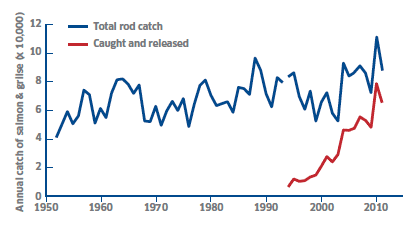
Figure 2 Trends in stock components, rod and line fishery.
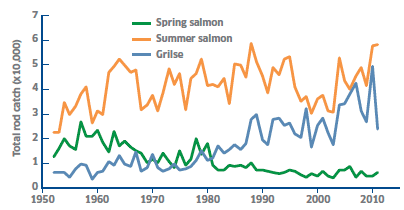
Trends in total rod catch vary among individual stock components (Figure 2). Spring salmon catch shows a general decline over the period. Although there is some indication that the catch has stabilised in recent years, it remains at a historically low level. Grilse catch, on the other hand, has generally increased over the period while the summer salmon catch shows little overall trend.
Catch and release
The proportion of the rod catch accounted for by catch and release has generally increased since 1994, when such information was first recorded. In 2011, 73% of the annual rod catch was released compared to less than 8% in 1994. Similarly, less than 1% of rod caught spring salmon were released in 1994 while 91% were released in 2011 (Figure 3).
Figure 3 Catch and release, rod and line fishery.
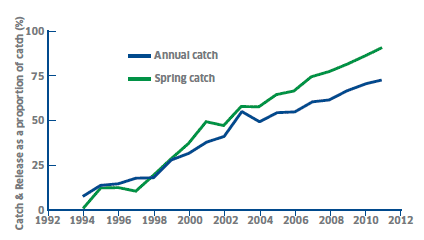
Figure 4 Fixed engine fishery.
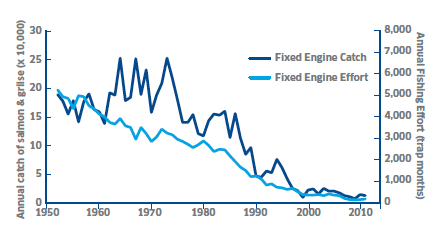
The net fisheries
13,802 wild salmon and grilse were reported caught and retained in the fixed engine fishery, and the national index of netting effort was 194.5 trap months. 6,016 wild salmon and grilse were reported caught and retained in the net & coble fishery, while the reported effort was 80 crew months.
Reported catch and effort have declined in both net fisheries over much of the period covered by our records and remain at historically low levels (Figures 4 & 5). In 2011, fishing effort in the fixed engine and net & coble fisheries was the fourth and fifth lowest, respectively, since records began in 1952. Reported catch in each fishery was 5% and 2% of the maximum reported in the respective time series.
Figure 5 Net and coble fishery.
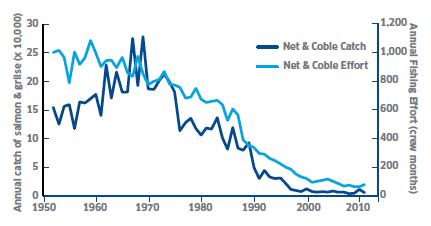
Farmed salmon and grilse
A total of 76 fish of farmed origin were reported caught by all methods in 2011. Salmon and grilse of farmed origin represented 0.1% of the total number of salmon and grilse caught, but the distribution of farmed origin fish was highly uneven, the North, North West and West regions accounting for 82% of reports (Figure 6).
Figure 6 North, North West and West Regions.

// INTERPRETATION
Recent events
The reported rod catch in 2011 showed a noticeable drop from the record catch in 2010. Total rod catch in 2011 was nevertheless 98% of the previous 5-year average and was the sixth highest on record.
It should be noted, however, that annual changes in catch are not a simple reflection of changes in the underlying numbers of fish returning to Scottish waters. Both catch size and the allocation of catch among fishing methods may be influenced by many factors, most obvious of which are often related to fishing effort or environmental factors. Thus, when inferring the status of stocks from catch data, it is important to consider trends over a number of years as well as focussing on catch levels for the most recent year.
The decline in net fisheries and in the numbers of salmon returning to home waters
Both fixed engine and net & coble fisheries have experienced considerable decline over the period since 1952 and catch and effort in both fisheries remain at historically low levels.
Marine survival of salmon has declined substantially over the period covered by the catch statistics. This is not unique to Scotland and similar declines have been detected in a number of monitored sites on both sides of the North Atlantic.
The numbers of salmon entering rivers appear to have increased
In contrast to the net fisheries, the rod and line catch shows an increase since 1952, when records began. Assuming no long term trends in rod exploitation rate over time, the contrasting fortunes of net and rod fisheries provide insights into the current status of Scottish salmon stocks.
Declines in the marine survival of salmon have led to lower numbers returning to the Scottish coast over much of the time series. Reductions in the netting industry over this period allowed a greater proportion of these fish to enter rivers, however, resulting in an increase in the numbers of fish available to the rod fisheries and escaping to spawn. The decline in the netting industry thus acted as a buffer for the rod fishery as marine survival declined.
Net catches are now less that 10% of those taken in the past and have remained at this level for the last decade while annual rod catches have continued to increase. In part, an increase in rod catch would be expected as catch-and-release has increased. However, these observations are consistent with data from Marine Scotland monitored sites which suggest that overall marine survival of Scottish salmon has now stabilised or is increasing.
The number of salmon escaping to spawn is an important factor in determining whether sufficient eggs have been deposited to fully use the rearing habitat and hence maximise subsequent smolt production. However, it is not just the number but also the size and condition of salmon that determines the total numbers of eggs deposited. Monitoring work indicates a decline in both the size and condition of salmon returning to Scottish waters which may act to reduce the average numbers of eggs carried by individuals. Marine Scotland Science continues its work in collaboration with the Universities of St Andrews and Glasgow to monitor the biological characteristics of returning adult salmon and to assess how these affect overall production of eggs and smolts.
Trends in abundance vary among stock components
There are clear differences in trends of catches of individual stock components over the time period that these stocks have been monitored. Thus, although rod catch as a whole has increased over the time series, the numbers of spring salmon in the catch have generally declined since the 1950s, and although spring salmon catch has stabilised in recent years, it remains at a historically low level. This pattern is consistent with information on adult spring salmon returning to sites monitored by Marine Scotland Science on upper tributaries of the Aberdeenshire Dee and runs over the Logie counter in the North Esk.
Interpretation of catch information at finer geographic scales ( e.g. particular components of the returning stock) may lead to interpretations of stock status which differ from an assessment based on total annual catch. Monitoring fisheries at such scales are therefore vital for a full assessment of the status of Scottish salmon stocks.
Downloads
Topic sheet no. 67 explains how we collect the catch statistics
and is available for download at
http://www.scotland.gov.uk/Topics/marine/science/Publications/TopicSheets/tslist
Summary data for the 2011 fishing season are available for
download at
http://www.scotland.gov.uk/Topics/marine/science/Publications/stats/SalmonSeaTroutCatches
The data provided for download are the best available at the time of publication. Our records are amended when further information is provided and the most accurate historical data may be obtained directly from us.
Contact
If you have a specific request for Scottish salmon and sea trout fishery information, please contact us directly at ms.catchform@scotland.gsi.gov.uk
Contact
There is a problem
Thanks for your feedback